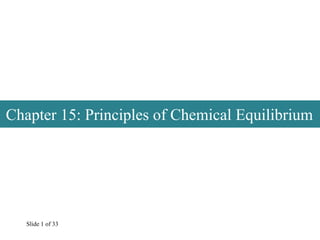Principles of Chemical Equilibrium.ppt
•Download as PPT, PDF•
0 likes•2 views
15-1 Dynamic Equilibrium 15-2 The Equilibrium Constant Expression 15-3 Relationships Involving Equilibrium Constants 15-4 The Magnitude of an Equilibrium Constant 15-5 The Reaction Quotient, Q: Predicting the Direction of a Net Change 15-6 Altering Equilibrium Conditions: Le Châtelier’s Principle 15-7 Equilibrium Calculations: Some Illustrative Examples
Report
Share
Report
Share

Recommended
Recommended
More Related Content
Similar to Principles of Chemical Equilibrium.ppt
Similar to Principles of Chemical Equilibrium.ppt (20)
�_CHAPTER4_Physical chemistry_Premidical_Equilibrium.pdf

�_CHAPTER4_Physical chemistry_Premidical_Equilibrium.pdf
�_CHAPTER4_Physical chemistry_Premidical_Equilibrium.pdf

�_CHAPTER4_Physical chemistry_Premidical_Equilibrium.pdf
Unit-6.pptEquilibrium concept and acid-base equilibrium

Unit-6.pptEquilibrium concept and acid-base equilibrium
5-Determining Equilibrium Constant General Chemistry 2

5-Determining Equilibrium Constant General Chemistry 2
Recently uploaded
Molecular and Cellular Mechanism of Action of Hormones such as Growth Hormone, Prolactin, InsulinMolecular and Cellular Mechanism of Action of Hormones such as Growth Hormone...

Molecular and Cellular Mechanism of Action of Hormones such as Growth Hormone...Ansari Aashif Raza Mohd Imtiyaz
Recently uploaded (20)
Harry Coumnas Thinks That Human Teleportation is Possible in Quantum Mechanic...

Harry Coumnas Thinks That Human Teleportation is Possible in Quantum Mechanic...
Efficient spin-up of Earth System Models usingsequence acceleration

Efficient spin-up of Earth System Models usingsequence acceleration
In-pond Race way systems for Aquaculture (IPRS).pptx

In-pond Race way systems for Aquaculture (IPRS).pptx
Isolation of AMF by wet sieving and decantation method pptx

Isolation of AMF by wet sieving and decantation method pptx
Mining Activity and Investment Opportunity in Myanmar.pptx

Mining Activity and Investment Opportunity in Myanmar.pptx
Molecular and Cellular Mechanism of Action of Hormones such as Growth Hormone...

Molecular and Cellular Mechanism of Action of Hormones such as Growth Hormone...
Factor Causing low production and physiology of mamary Gland

Factor Causing low production and physiology of mamary Gland
Film Coated Tablet and Film Coating raw materials.pdf

Film Coated Tablet and Film Coating raw materials.pdf
SaffronCrocusGenomicsThessalonikiOnlineMay2024TalkOnline.pptx

SaffronCrocusGenomicsThessalonikiOnlineMay2024TalkOnline.pptx
Soil and Water Conservation Engineering (SWCE) is a specialized field of stud...

Soil and Water Conservation Engineering (SWCE) is a specialized field of stud...
POST TRANSCRIPTIONAL GENE SILENCING-AN INTRODUCTION.pptx

POST TRANSCRIPTIONAL GENE SILENCING-AN INTRODUCTION.pptx
GBSN - Microbiology (Unit 7) Microbiology in Everyday Life

GBSN - Microbiology (Unit 7) Microbiology in Everyday Life
Principles of Chemical Equilibrium.ppt
- 1. Slide 1 of 33 Chapter 15: Principles of Chemical Equilibrium
- 2. Slide 2 of 33 Contents 15-1 Dynamic Equilibrium 15-2 The Equilibrium Constant Expression 15-3 Relationships Involving Equilibrium Constants 15-4 The Magnitude of an Equilibrium Constant 15-5 The Reaction Quotient, Q: Predicting the Direction of a Net Change 15-6 Altering Equilibrium Conditions: Le Châtelier’s Principle 15-7 Equilibrium Calculations: Some Illustrative Examples
- 3. Slide 3 of 33 15-1 Dynamic Equilibrium Equilibrium – two opposing processes taking place at equal rates. H2O(l) H2O(g) I2(H2O) I2(CCl4) NaCl(s) NaCl(aq) H2O CO(g) + 2 H2(g) CH3OH(g)
- 4. Slide 4 of 33 Dynamic Equilibrium
- 5. Slide 5 of 33 15-2 The Equilibrium Constant Expression Methanol synthesis is a reversible reaction. CO(g) + 2 H2(g) CH3OH(g) k1 k-1 CH3OH(g) CO(g) + 2 H2(g) CO(g) + 2 H2(g) CH3OH(g) k1 k-1
- 6. Slide 6 of 33 Three Approaches to the Equilibrium
- 7. Slide 7 of 33 Three Approaches to Equilibrium
- 8. Slide 8 of 33 Three Approaches to Equilibrium CO(g) + 2 H2(g) CH3OH(g) k1 k-1
- 9. Slide 9 of 33 The Equilibrium Constant Expression Forward: CO(g) + 2 H2(g) → CH3OH(g) Reverse: CH3OH(g) → CO(g) + 2 H2(g) At Equilibrium: Rfwrd = k1[CO][H2]2 Rrvrs = k-1[CH3OH] Rfwrd = Rrvrs k1[CO][H2]2 = k-1[CH3OH] [CH3OH] [CO][H2]2 = k1 k-1 = Kc CO(g) + 2 H2(g) CH3OH(g) k1 k-1 k1 k-1
- 10. Slide 10 of 33 General Expressions a A + b B …. → g G + h H …. Equilibrium constant = Kc= [A]m[B]n …. [G]g[H]h ….
- 11. Slide 11 of 33 15-3 Relationships Involving the Equilibrium Constant Reversing an equation causes inversion of K. Multiplying by coefficients by a common factor raises the equilibrium constant to the corresponding power. Dividing the coefficients by a common factor causes the equilibrium constant to be taken to that root.
- 12. Slide 12 of 33 Combining Equilibrium Constant Expressions N2O(g) + ½O2 2 NO(g) Kc= ? Kc= [N2O][O2]½ [NO]2 = [N2][O2]½ [N2O] [N2][O2] [NO]2 Kc(2) 1 Kc(3) = = 1.710-13 [N2][O2] [NO]2 = [N2][O2]½ [N2O] = N2(g) + ½O2 N2O(g) Kc(2)= 2.710-18 N2(g) + O2 2 NO(g) Kc(3)= 4.710-31
- 13. Slide 13 of 33 KP = Kc(RT)Δn :
- 14. Slide 14 of 33 Pure Liquids and Solids Equilibrium constant expressions do not contain concentration terms for solid or liquid phases of a single component (that is, pure solids or liquids). Kc = [H2O]2 [CO][H2] C(s) + H2O(g) CO(g) + H2(g)
- 15. Slide 15 of 33 Worked Examples Follow:
- 16. Slide 16 of 33 15-1 Practice Example B
- 17. Slide 17 of 33
- 18. Slide 18 of 33
- 19. Slide 19 of 33 CRS Questions Follow:
- 20. Slide 20 of 33 H2 CO CH4 = H2O time moles of substance 0 1 2 3 f r k 2 4 2 k CO(g) + 3H (g) CH (g) + H O(g) Which of the following statements is correct? 1. At equilibrium the reaction stops. 2. At equilibrium the rate constants for the forward and reverse reactions are equal. 3. At equilibrium the rates of the forward and reverse reactions are equal. 4. At equilibrium the rates of the forward and reverse reactions are zero.
- 21. Slide 21 of 33 H2 CO CH4 = H2O time moles of substance 0 1 2 3 f r k 2 4 2 k CO(g) + 3H (g) CH (g) + H O(g) Which of the following statements is correct? 1. At equilibrium the reaction stops. 2. At equilibrium the rate constants for the forward and reverse reactions are equal. 3. At equilibrium the rates of the forward and reverse reactions are equal. 4. At equilibrium the rates of the forward and reverse reactions are zero.
Editor's Notes
- 1
- 2
- 6
- 10